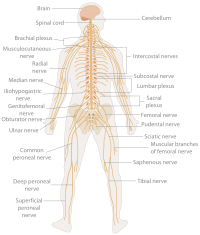
Photo from wikipedia
Several studies have indicated that coherent circadian rhythms in behaviour can be manifested only when the underlying circadian oscillators function as a well-coupled network. The current literature suggests that circadian… Click to show full abstract
Several studies have indicated that coherent circadian rhythms in behaviour can be manifested only when the underlying circadian oscillators function as a well-coupled network. The current literature suggests that circadian pacemaker neuronal networks rely heavily on communication mediated by chemical synapses comprising neuropeptides and neurotransmitters to regulate several behaviours and physiological processes. It has become increasingly clear that chemical synapses closely interact with electrical synapses and function together in the neuronal networks of most organisms. However, there are only a few studies which have examined the role of electrical synapses in circadian networks and here, we review our current understanding of gap junction proteins in circadian networks of various model systems. We describe the general mechanisms by which electrical synapses function in neural networks, their interactions with chemical neuromodulators and their contributions to the regulation of circadian rhythms. We also discuss the various methods available to characterize functional electrical synapses in these networks and the potential directions that remain to be explored to understand the roles of this relatively understudied mechanism of communication in modulating circadian behaviour.
Journal Title: Frontiers in Physiology
Year Published: 2022
Link to full text (if available)
Share on Social Media: Sign Up to like & get
recommendations!